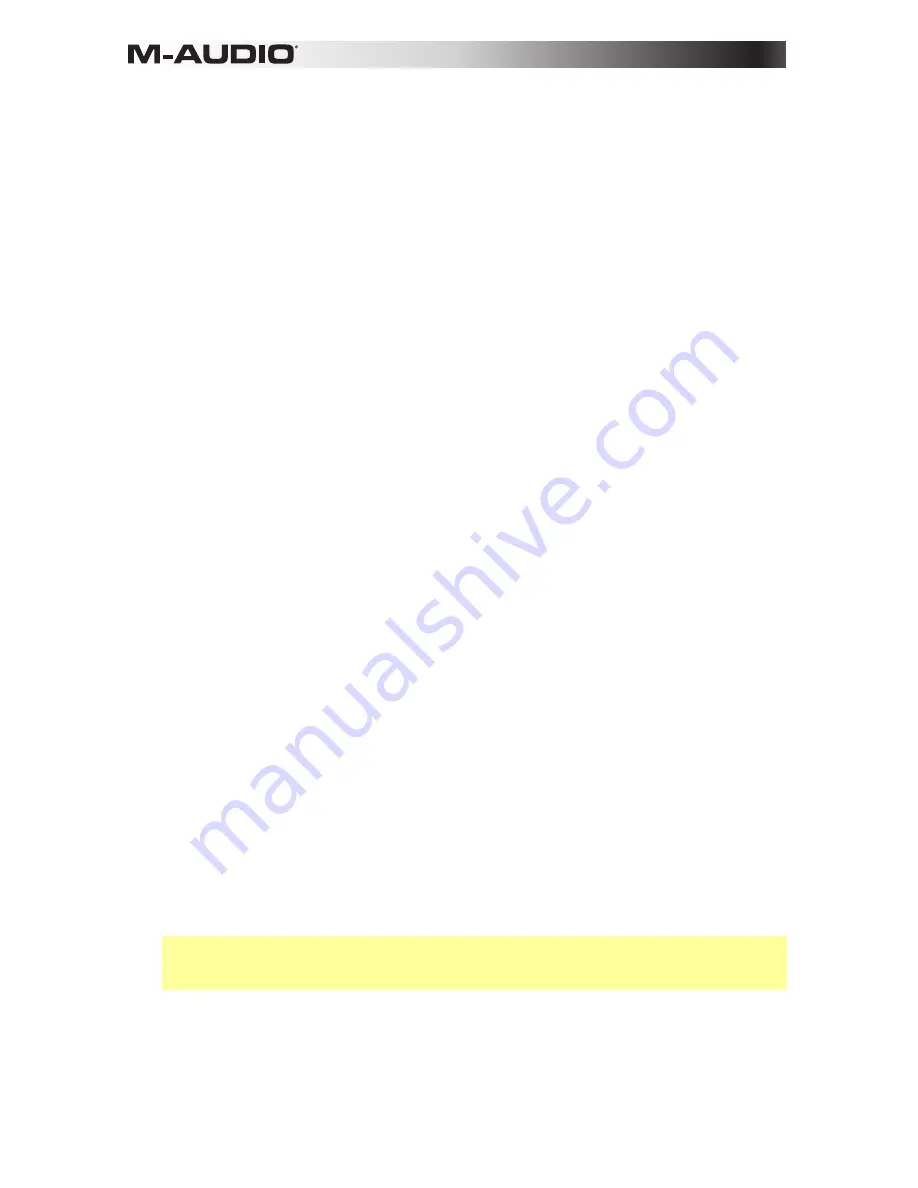
8
8.
Save:
Press this button to save the current Preset, Sequence, Preferences, or all three.
Press and hold this button for 2-3 seconds to save all of Trigger Finger Pro's settings and
current state.
9.
Knobs:
Use these 360º knobs to send MIDI CC messages to your software or external
MIDI device. Alternatively, you can set the knobs to communicate with your software
using the Mackie Control or HUI protocols or to communicate with Arsenal. See the
Basic Operation:
Modes
section of this guide for more information.
In Pad Mode and Sequence Mode, use these knobs to adjust the parameters shown right
above them in the display.
10.
Faders:
Use these faders to send MIDI CC messages to your software or external MIDI
device. Alternatively, you can set the faders to communicate with your software using the
Mackie Control or HUI protocols or to communicate with Arsenal. See the
Basic
Operation:
Modes
section of this guide for more information.
11.
Assignable Buttons:
Use these buttons to send MIDI CC messages or Program Change
messages to your software or external MIDI device. They can function as momentary,
toggle (latching), or single-message buttons. Alternatively, you can set the buttons to
communicate with your software using the Mackie Control or HUI protocols or to
communicate with Arsenal. See the
Basic Operation:
Modes
section of this guide for
more information.
12.
Control Bank:
Press this button to cycle through the four independent banks of
knobs
,
faders
, and
assignable buttons
. The current control bank letter (A–D) will appear in the
display. All 12 physical controls will always be in the same bank (e.g., you cannot adjust a
knob in Control Bank A and a fader in Control Bank B simultaneously).
Press and hold this button to see an overview of the control mapping (
MIDI
,
Mackie
Control
,
HUI
, or
Arsenal
) for the entire control bank. Use the
assignable buttons
to
select the control bank you are viewing.
13.
Pads:
Use these pads to trigger drum hits or other samples in your software or external
MIDI sound module. The pads are pressure- and velocity-sensitive, which makes them
very responsive and intuitive to play.
14.
Pad Bank:
Press this button to cycle through the four independent banks of
pads
. The
current pad bank letter (
A–D
) will appear in the display.
Press and hold this button to access the pads' secondary functions:
•
Press
Pad 1
,
2
,
3
, or
4
to directly select
Pad Bank A
,
B
,
C
, or
D
(respectively).
•
Press and hold
Pad 9
,
10
,
11
, or
12
to mute or unmute
Pad Bank A
,
B
,
C
, or
D
(respectively) in the current Sequence. This is essentially a momentary mute feature
for each pad bank.
•
Press
Pad 13
,
14
,
15
, or
16
to mute or unmute
Pad Bank A
,
B
,
C,
or
D
(respectively)
in the current Sequence. This is essentially a toggle (latching) mute feature for each
pad bank.
15.
Roll:
Press this button to activate or deactivate Pad Roll Mode. When you press and hold
a pad while in this mode, the sound will repeat at the rate determined by the current Time
Division setting.
Important:
The Time Division setting affects both Sequence playback and Pad Roll
Mode. In other words, the rate of a pad roll will always correspond to the Sequence's
Time Division.
16.
Fixed:
Press this button to activate or deactivate Fixed Mode in which all pads will play
their sounds at a fixed velocity level (which can be set in Pad Mode), regardless of how
hard you hit them.
Содержание tirgger finger pro
Страница 10: ...m audio com Manual Version 1 0...










